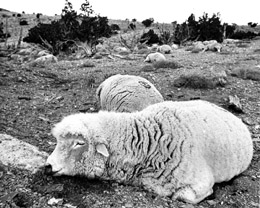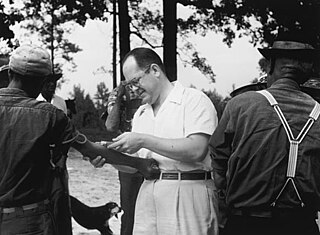Related Research Articles
Incapacitating agent is a chemical or biological agent which renders a person unable to harm themselves or others, regardless of consciousness.

Project SHAD, an acronym for Shipboard Hazard and Defense, was part of a larger effort called Project 112, which was conducted during the 1960s. Project SHAD encompassed tests designed to identify U.S. warships' vulnerabilities to attacks with chemical agents or biological warfare agents and to develop procedures to respond to such attacks while maintaining a war-fighting capability.

Beginning in the mid-1930s, Japan conducted numerous attempts to acquire and develop weapons of mass destruction. The 1943 Battle of Changde saw Japanese use of both bioweapons and chemical weapons, and the Japanese conducted a serious, though futile, nuclear weapon program.

The Chemical Corps is the branch of the United States Army tasked with defending against chemical, biological, radiological, and nuclear (CBRN) weapons. The Chemical Warfare Service was established on 28 June 1918, combining activities that until then had been dispersed among five separate agencies of the United States federal government. It was made a permanent branch of the Regular Army by the National Defense Act of 1920. In 1945, it was redesignated the Chemical Corps.
The United States biological weapons program officially began in spring 1943 on orders from U.S. President Franklin Roosevelt. Research continued following World War II as the U.S. built up a large stockpile of biological agents and weapons. Over the course of its 27-year history, the program weaponized and stockpiled the following seven bio-agents :

The Dugway sheep incident, also known as the Skull Valley sheep kill, was a March 1968 sheep kill that has been connected to United States Army chemical and biological warfare programs at Dugway Proving Ground in Utah. Six thousand sheep were killed on ranches near the base, and the popular explanation blamed Army testing of chemical weapons for the incident, though alternative explanations have been offered. A report, commissioned by Air Force Press Officer Jesse Stay and first made public in 1998, was called the "first documented admission" from the Army that a nerve agent killed the sheep at Skull Valley.

Project 112 was a biological and chemical weapon experimentation project conducted by the United States Department of Defense from 1962 to 1973.

The Operational Test and Evaluation Force (OPTEVFOR) is an independent and objective agency within the United States Navy for the operational testing and evaluation (OT&E) of naval aviation, surface warfare, submarine warfare, C4I, cryptologic, and space systems in support Navy and Department of Defense acquisition programs.

The U.S. Army Biological Warfare Laboratories (USBWL) was a suite of research laboratories and pilot plant centers operating at Camp Detrick, Maryland, United States, beginning in 1943 under the control of the U.S. Army Chemical Corps Research and Development Command. The USBWL undertook research and development into biocontainment, decontamination, gaseous sterilization, and agent production and purification for the U.S. offensive biological warfare program. The laboratories and their projects were discontinued in 1969.

Operation LAC was a United States Army Chemical Corps operation which dispersed microscopic zinc cadmium sulfide (ZnCdS) particles over much of the United States and Canada in order to test dispersal patterns and the geographic range of chemical or biological weapons.

The Deseret Test Center was a U.S. Army operated command in charge for testing chemical and biological weapons during the 1960s. The Deseret was headquartered at Fort Douglas, Utah, a former U.S. Army base.
Entomological warfare (EW) is a type of biological warfare that uses insects to interrupt supply lines by damaging crops, or to directly harm enemy combatants and civilian populations. There have been several programs which have attempted to institute this methodology; however, there has been limited application of entomological warfare against military or civilian targets, Japan being the only state known to have verifiably implemented the method against another state, namely the Chinese during World War II. However, EW was used more widely in antiquity, in order to repel sieges or cause economic harm to states. Research into EW was conducted during both World War II and the Cold War by numerous states such as the Soviet Union, United States, Germany and Canada. There have also been suggestions that it could be implemented by non-state actors in a form of bioterrorism. Under the Biological and Toxic Weapons Convention of 1972, use of insects to administer agents or toxins for hostile purposes is deemed to be against international law.
Operation May Day was a series of entomological warfare (EW) tests conducted by the U.S. military in Savannah, Georgia, in 1956.

Operation Big Itch was a U.S. entomological warfare field test using uninfected fleas to determine their coverage and survivability as a vector for biological agents. The tests were conducted at Dugway Proving Ground in 1954.
Operation Big Buzz was a U.S. military entomological warfare field test conducted in the U.S. city of Savannah, Georgia in 1955. The tests involved dispersing over 300,000 mosquitoes from aircraft and through ground dispersal methods.
The E14 munition was a cardboard sub-munition developed by the United States biological weapons program as an anti-crop weapon. In a series of field tests in 1955, the E14 was loaded with fleas and air-dropped.
The E23 munition was a cardboard sub-munition developed by the United States biological weapons program for use as an anti-crop weapon. The E23 underwent a conversion for use as a vector weapon and was briefly used in large-scale entomological warfare trial but technical issues forced it from the tests.

Numerous experiments which are performed on human test subjects in the United States are considered unethical, because they are performed without the knowledge or informed consent of the test subjects. Such tests have been performed throughout American history, but some of them are ongoing. The experiments include the exposure of humans to many chemical and biological weapons, human radiation experiments, injections of toxic and radioactive chemicals, surgical experiments, interrogation and torture experiments, tests which involve mind-altering substances, and a wide variety of other experiments. Many of these tests are performed on children, the sick, and mentally disabled individuals, often under the guise of "medical treatment". In many of the studies, a large portion of the subjects were poor, racial minorities, or prisoners.

Herbicidal warfare research conducted by the U.S. military began during the Second World War with additional research during the Korean War. Interest among military strategists waned before a budgetary increase allowed further research during the early Vietnam War. The U.S. research culminated in the U.S. military defoliation program during the Vietnam war known as Operation Ranch Hand.
References
- ↑ Rose, William H. "An Evaluation of Entomological Warfare as a Potential Danger to the United States and European NATO Nations", U.S. Army Test and Evaluation Command, Dugway Proving Ground, March 1981, via thesmokinggun.com , accessed December 25, 2008
- ↑ "Summary of Major Events and Problems: (Reports Control Syrnbol CSHIS-6) United States Army Chemical Corps, Fiscal Year 1959". United States Army Chemical Corps. pp. 101–104. Retrieved 2013-12-16.
- ↑ Summary of Major Events and Problems (Reports Control Symbol CSHIS-6) (Technical report). United States Army Chemical Corps. 1960-01-01. Retrieved 2008-12-28.
- ↑ "Memorable quotes for Dr. Strangelove or: How I Learned to Stop Worrying and Love the Bomb". IMDb . Retrieved 2008-12-28.
- ↑ "Recap / Archer S 5 E 13 Arrival Departure" . Retrieved 2017-12-17.